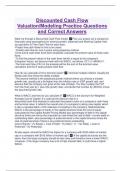Exam (elaborations)
Discounted Cash Flow Valuation/Modeling Practice Questions and Correct Answers
- Course
- Institution
Walk me through a Discounted Cash Flow model. First, you project out a company's financials using assumptions for revenue growth, expenses and Working Capital; then you get down to Free Cash Flow for each year, -Project free cash flows for five to ten years. - Predict cash flow for over 5 years usi...
[Show more]



